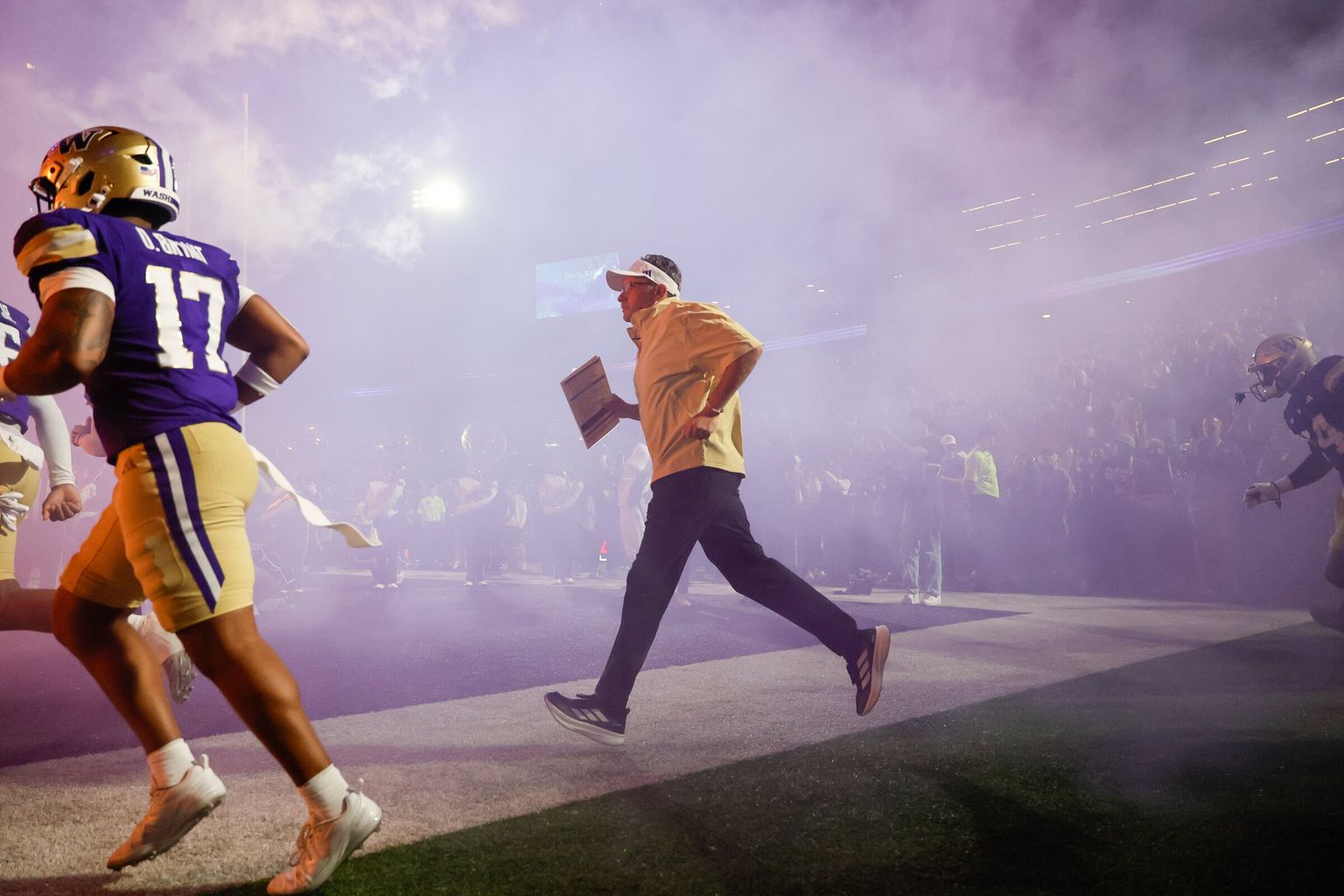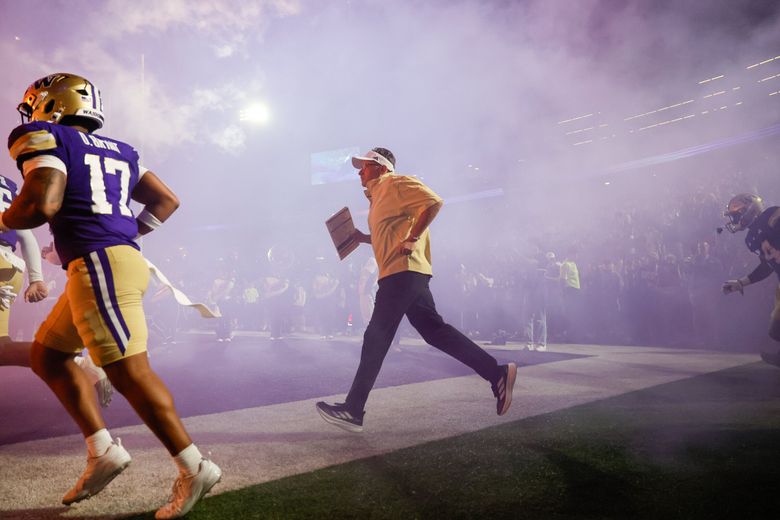What Big Ten’s private capital bid could mean for Washington | Analysis

Washington football coach Jedd Fisch runs out onto the field before the start of a game against UC Davis last month. (Jennifer Buchanan / The Seattle Times)
Washington football coach Jedd Fisch runs out onto the field before the start of a game against UC Davis last month. (Jennifer Buchanan / The Seattle Times)
By Jon Wilner Bay Area News Group
The Big Ten is fast approaching decision day, when the 18 university presidents must approve or reject a groundbreaking financial arrangement with an outside investor that would provide financial stability and long-term security.
In exchange, the conference would relinquish a piece of its soul. Err, sorry — its soul would remain intact (in theory), but the Big Ten would relinquish an ownership stake in a newly created for-profit entity.
For those unfamiliar, there are four primary elements, per published reports.
— An infusion of $2.4 billion from the investment arm of the University of California system, which would receive a 10% ownership stake in the Big Ten’s revenue-generation arm. Each school would have immediate access to more than $100 million, which could be used to cover debt service (on facilities) or assist with revenue-sharing or other costs. Some schools might even use the cash to help grow their revenues.
— The Big Ten would establish revenue tiers, with initial cash payments from the $2.4 billion infusion based on brand value. (The conference is expected to implement a performance-based distribution model, as well.) Ohio State, Michigan and Penn State would be on the top tier for initial cash payments, according to a source, with USC and Oregon on the second tier and everyone else on the third.
Advertising Skip AdSkip AdSkip Ad
— An extension of the grant-of-rights agreement (GOR), which binds the 18 universities to the Big Ten. The current GOR expires in 2036. Under the terms of the private capital deal, the schools would extend the GOR until 2046, meaning Ohio State and Michigan (and others) could not leave for a super league.
— The conference would create a commercial arm, called Big Ten Enterprises (BTE), responsible for revenue generation (media rights, sponsorships, etc.) The presidents would oversee BTE, which would be divided into 20 shares worth 5% each. Every school would receive 5% of the revenue, as would the conference office and the investing firm.
Each of the components has benefits and drawbacks.
The cash would relieve pressure created by the $20.5 million in revenue sharing — a line-item expense for the schools.
But how would UC Investments be repaid? Are the schools mortgaging their future to cover present-day expenses? Would the creation of a commercial arm impact the tax-exempt status that the Big Ten athletic departments currently enjoy?
Those are just a few of the unanswered questions.
The 20-year extension of the GOR carries a double edge, as well. Sure, security is nice — if you’re Purdue and Rutgers. But why would Michigan, Ohio State, Penn State and USC bind themselves to the conference for the equivalent of three lifetimes in college sports?
The private capital deal doesn’t impact each school the same way. That’s true even of the Big Ten’s West Coast members.
Advertising Skip Ad
Borrowing money to cover expenses is hardly an ideal approach. But Washington doesn’t have easy answers. In fact, the Huskies face arguably the most challenging financial picture.
Unlike USC and UCLA, both Washington and Oregon receive half shares of the Big Ten’s annual media rights for the five remaining years of the current deal with Fox, CBS and NBC.
But unlike Oregon, the Huskies don’t have an equivalent of Phil Knight.
Washington’s combination of half-share status and debt service payments (for the Husky Stadium renovation) — plus the $20.5 million line item for revenue sharing — creates a triple whammy that either doesn’t exist for the other West Coast schools or cannot be offset with philanthropy.
(Oregon’s athletic department balances its budget each year without campus support, whereas Washington relies on roughly $10 million from campus, and UCLA athletics took a $30 million assist last year. USC’s finances are private.)
So, yes: The cash infusion will relieve fiscal stress.
But Washington’s motivation for approving the deal is based as much on the security it provides as the dollars it injects.
Advertising Skip AdSkip AdSkip Ad
If the Big Ten doesn’t extend the grant-of-rights agreement, two dates become immediately relevant:
— 2030, when the Big Ten’s media deal with Fox, NBC and CBS expires and the cost for schools to exit the ACC plunges. That combination could lead to the next realignment wave and, perhaps, a major restructuring of the sport.
— 2036, when the Big Ten’s current grant-of-rights expires.
Either instance could lead to disruption that places the Huskies in a less advantageous position than they would experience if the Big Ten stayed intact until 2046.
For the Huskies, the private capital deal offers intermediate-term financial relief and long-term security.
Does that mean it would be a sweet deal for UW specifically and the Big Ten generally? Not necessarily.
At least two schools, Michigan and USC, have reservations, according to a source. Whether they ultimately stand in the way should be clear by the end of the month, if not sooner.
But this much is sure: If the Big Ten sells an ownership stake to an outside investment firm, there is no going back.
“They will have no choice but to keep selling and selling and selling,” another source said. “The presidents would be tying the hands of their successors for years to come because they need more money now.”
Jon Wilner: jwilner@bayareanewsgroup .com. Jon Wilner has been covering college sports for decades and is an AP top-25 football and basketball voter as well as a Heisman Trophy voter. He was named Beat Writer of the Year in 2013 by the Football Writers Association of America for his coverage of the Pac-12, won first place for feature writing in 2016 in the Associated Press Sports Editors writing contest and is a five-time APSE honoree.
Comments
-
Ohio State, Michigan and Penn State would be on the top tier for initial cash payments, according to a source, with USC and Oregon on the second tier and everyone else on the third.
Fuck this shit, why are we agreeing? If it is based on history then why the fuck are we behind Oregon?
If it is based on recency then why the fuck are we behind USC?
Hopefully Wilner is wrong about all of this.
-
I think I read somewhere that the difference between the top and the bottom would be less than 1%. Feel, like it's more about chest puffing and peacock feathers than actual difference making financial tiers.
-
This is what happens when you put together an oversized conference full of schools that are trash when it comes to football. Look at the weekly matchups and tell me how many of the B1G games are appealing for national tv. The best game this coming weekend is a non-conference game for USC playing at Notre Dame. Anybody seen how laughable Ohio State and Indiana's schedules are the rest of the season? May as well not even play the games.
The B1G needs to create better programs to appeal to their TV overlords in time to negotiate a better TV contract for the conference. There is almost zero middle-class in the B1G right now. Meanwhile, the SEC has 10 teams in the top-25 and can put compelling games on national TV every weekend.
The have-not programs are all begging for the money to upgrade their programs and payrolls. Giving poor people tons of money for the first time in their life always turns out well, right?!
Upper Class
- Ohio State
- Michigan
- USC
- Oregon
- Penn State (they could fall behind pretty soon if they mess up their next HC hire)
Middle Class
- UW
- Indiana (they are upper class this year, but let's be real - even putting them here is generous)
- Nebraska
Lower Class (NOC about any of these schools when it comes to football)
- Rutgers
- Purdue
- Wisconsin
- Michigan State
- Maryland
- Illinois
- UCLA
- Northwestern
- Minnesota
- Iowa
Pros of private capital
- Ensures a conference format for 20 more years
- Maybe UW can finally pay off the stadium
- No NFL-style super-conference realignment
Cons of private capital
- Mortgaging future revenues for a quick fix
- Keeps UW locked into this dogshit conference for 20 years. Over half of the schools in the B1G are garbage and aren't even located in places where anybody would ever want to visit.
-
The SEC going to 9 games will make their middle seem a little softer. Instead of eight or nine 10-3 teams or better they will have a lot more 9-4/8-5 type teams just like the B10. If Nebraska and UW can solidify themselves as legit top 20 powers year in year out and Wisconsin can reclaim their place as a 8-10 win program yearly then the profile of the B10 gets a bump. It would also help if the Penn St job doesn’t cut the knees off of Indiana or Nebraska which it might depending on who takes that job. Cigarette has Indiana in rarefied air and Rhule finally has Nebraska at a point where they don’t seem like a joke anymore.
-
wilner said it, so its probably bullshit. even if its remotely true, how in the fuck is the UC system going to be repaid? what if the b!g cant come up with the money. and the UC system wants to invest in college sports? seems pretty off-brand since cal and ucla dont give a fuck about football.
-
I do believe the SEC is stronger in the middle (this year and most), however the B1G middle is currently under-ranked compared to the SEC. It's primarily perception coming from a starting point where you would really have to step on your dick (a la PSU) to be punished.
Also, the B1G has more that 3 classes, probably 5 classes. Ohio State is in a class of its own at the top, and Iowa/Wisconsin/MSU should be separate from the rest of the dreck. Nebraska is probably in that class too until they get to 10 wins this year.
-
Great points about the tiers. Iowa, Wisconsin and Iowa should all be above the dreck. They all have the potential to be good programs.
-
…and Iowa.
-
Did I forget to mention Iowa? Thanks Bazey
-
Saw UW and Nebraska in your "Middle Class" and stopped reading.







